fuel cap MERCEDES-BENZ C-CLASS COUPE 2018 Owner's Manual
[x] Cancel search | Manufacturer: MERCEDES-BENZ, Model Year: 2018, Model line: C-CLASS COUPE, Model: MERCEDES-BENZ C-CLASS COUPE 2018Pages: 354, PDF Size: 5.88 MB
Page 13 of 354
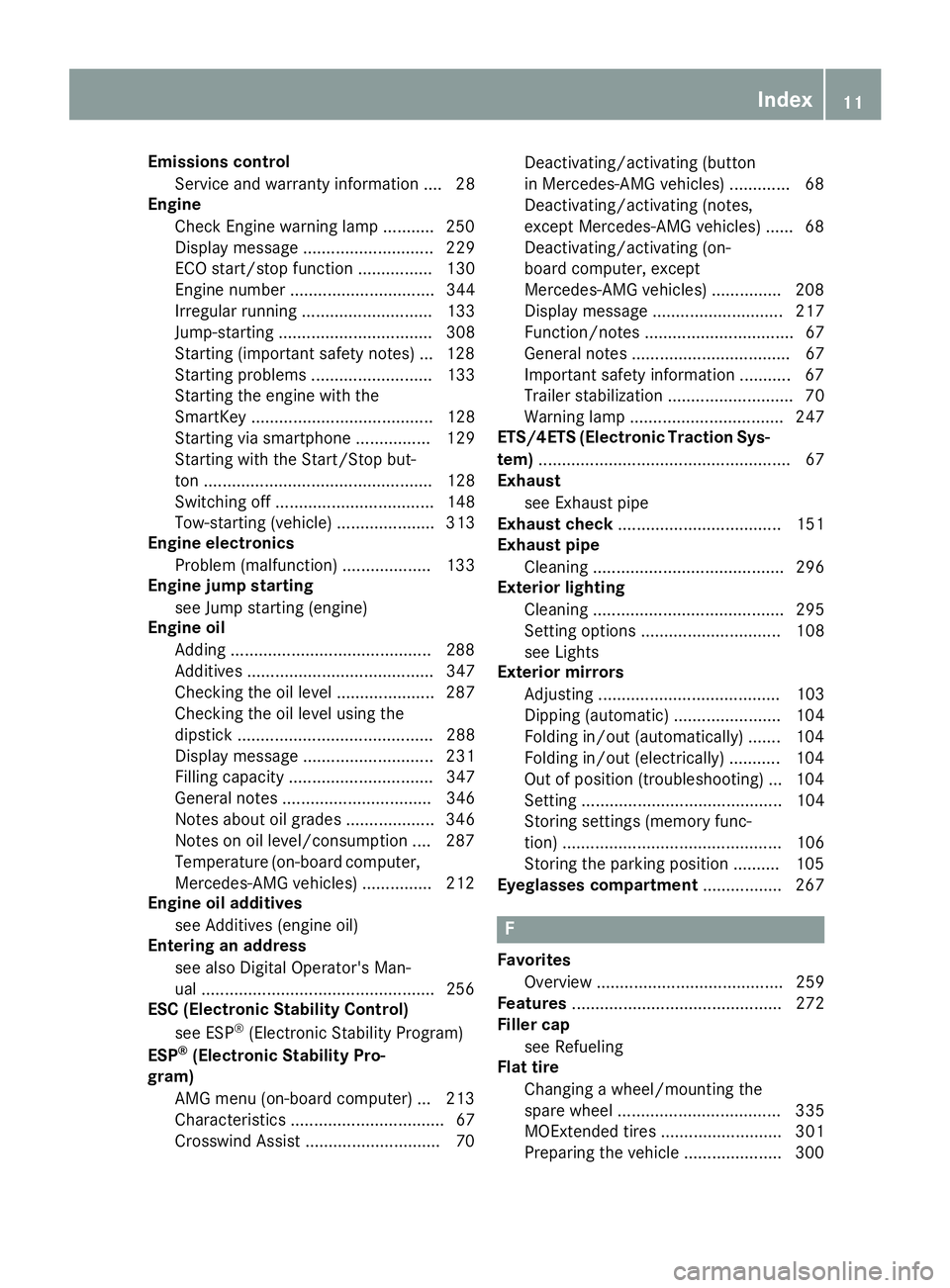
Emissions controlService and warranty information .... 28
Engine
Check Engine warning lamp .......... .250
Display message ............................ 229
ECO start/stop function ................ 130
Engine number ............................... 344
Irregular running ............................ 133
Jump-starting ................................. 308
Starting (important safety notes) ... 128
Starting problems .......................... 133
Starting the engine with the
SmartKey ....................................... 128
Starting via smartphone ................ 129
Starting with the Start/Stop but-
ton ................................................. 128
Switching off .................................. 148
Tow-starting (vehicle) ..................... 313
Engine electronics
Problem (malfunction) ................... 133
Engine jump starting
see Jump starting (engine)
Engine oil
Adding ...........................................2 88
Additives ........................................ 347
Checking the oil level ..................... 287
Checking the oil level using the
dipstick .......................................... 288
Display message ............................ 231
Filling capacity ............................... 347
General notes ................................ 346
Notes about oil grades ................... 346
Notes on oil level/consumption .... 287
Temperature (on-board computer,
Mercedes-AMG vehicles) ...............2 12
Engine oil additives
see Additives (engine oil)
Entering an address
see also Digital Operator's Man-
ual ..................................................2 56
ESC (Electronic Stability Control)
see ESP
®(Electronic Stability Program)
ESP®(Electronic Stability Pro-
gram)
AMG menu (on-board computer) ... 213
Characteristics ................................. 67
Crosswind Assist .............................7 0Deactivating/activating (button
in Mercedes-AMG vehicles) .............6
8
Deactivating/activating (note
s,
except Mercedes-AMG vehicles) ...... 68
Deactivating/activating (on-
board computer, except
Mercedes-AMG vehicles) ............... 208
Display message ............................ 217
Function/notes ................................ 67
General notes .................................. 67
Important safety information ........... 67
Trailer stabilization ........................... 70
Warning lamp ................................. 247
ETS/4ETS (Electronic Traction Sys-
tem) ...................................................... 67
Exhaust
see Exhaust pipe
Exhaust check ................................... 151
Exhaust pipe
Cleaning ......................................... 296
Exterior lighting
Cleaning ......................................... 295
Setting options .............................. 108
see Lights
Exterior mirrors
Adjusting ....................................... 103
Dipping (automatic) ....................... 104
Folding in/out (automatically) ....... 104
Folding in/out (electrically) ........... 104
Out of position (troubleshooting) ... 104
Setting ........................................... 104
Storing settings (memory func-
tion) ............................................... 106
Storing the parking position .......... 105
Eyeglasses compartment ................. 267
F
Favorites
Overview ........................................ 259
Features ............................................. 272
Filler cap
see Refueling
Flat tire
Changing a wheel/mounting the
spare wheel ................................... 335
MOExtended tires .......................... 301
Preparing the vehicle ..................... 300
Index11
Page 14 of 354
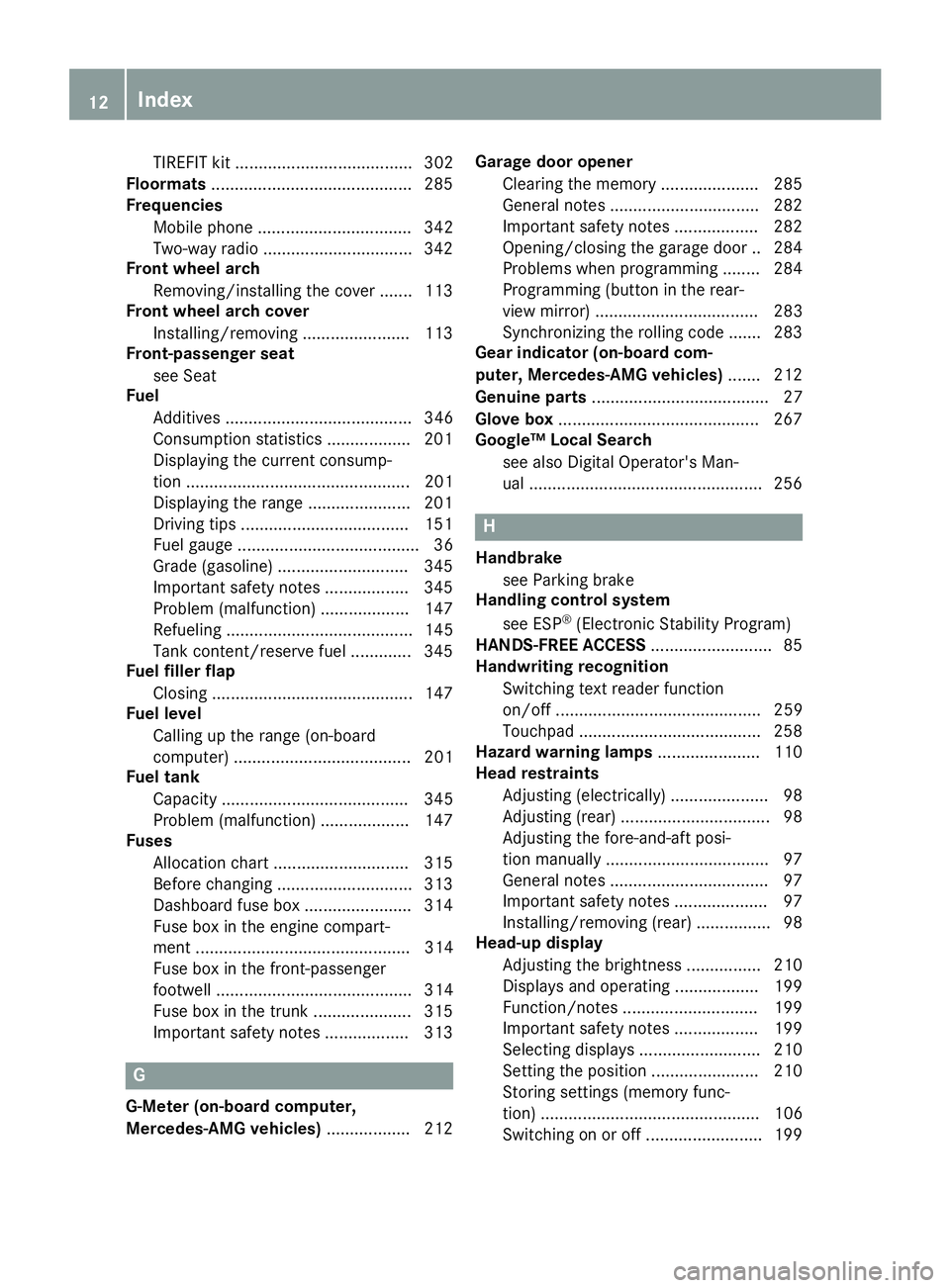
TIREFIT kit ...................................... 302
Floormats ...........................................2 85
Frequencies
Mobile phone ................................. 342
Two-way radio ................................ 342
Front wheel arch
Removing/installing the cover ....... 113
Front wheel arch cover
Installing/removing ....................... 113
Front-passenger seat
see Seat
Fuel
Additives ........................................ 346
Consumption statistics .................. 201
Displaying the current consump-
tion ................................................ 201
Displaying the range ......................2 01
Driving tips ....................................1 51
Fuel gauge ....................................... 36
Grade (gasoline) ............................ 345
Important safety notes .................. 345
Problem (malfunction) ................... 147
Refueling ........................................ 145
Tank content/reserve fuel ............. 345
Fuel filler flap
Closing ...........................................1 47
Fuel level
Calling up the range (on-board
computer) ...................................... 201
Fuel tank
Capacity ........................................ 345
Problem (malfunction) ................... 147
Fuses
Allocation chart .............................3 15
Before changing .............................3 13
Dashboard fuse box ....................... 314
Fuse box in the engine compart-
ment .............................................. 314
Fuse box in the front-passenger
footwell .......................................... 314
Fuse box in the trunk ..................... 315
Important safety notes .................. 313
G
G-Meter (on-board computer,
Mercedes-AMG vehicles) .................. 212Garage door opener
Clearing the memory ..................... 285
General notes ................................ 282
Important safety notes .................. 282
Opening/closing the garage door .. 284
Problems when programming ........2 84
Programming (button in the rear-
view mirror) ................................... 283
Synchronizing the rolling code ....... 283
Gear indicator (on-board com-
puter, Mercedes-AMG vehicles) ....... 212
Genuine parts ...................................... 27
Glove box ...........................................2 67
Google™ Local Search
see also Digital Operator's Man-
ual ..................................................2 56
H
Handbrake
see Parking brake
Handling control system
see ESP
®(Electronic Stability Program)
HANDS-FREE ACCESS .......................... 85
Handwriting recognition
Switching text reader function
on/off ............................................ 259
Touchpad ....................................... 258
Hazard warning lamps ......................110
Head restraints
Adjusting (electrically) ..................... 98
Adjusting (rear) ................................ 98
Adjusting the fore-and-aft posi-
tion manually ................................... 97
General notes .................................. 97
Important safety notes .................... 97
Installing/removing (rear) ................ 98
Head-up display
Adjusting the brightness ................ 210
Displays and operating .................. 199
Function/notes .............................1 99
Important safety notes .................. 199
Selecting displays .......................... 210
Setting the position ....................... 210
Storing settings (memory func-
tion) ............................................... 106
Switching on or off ......................... 199
12Index
Page 23 of 354
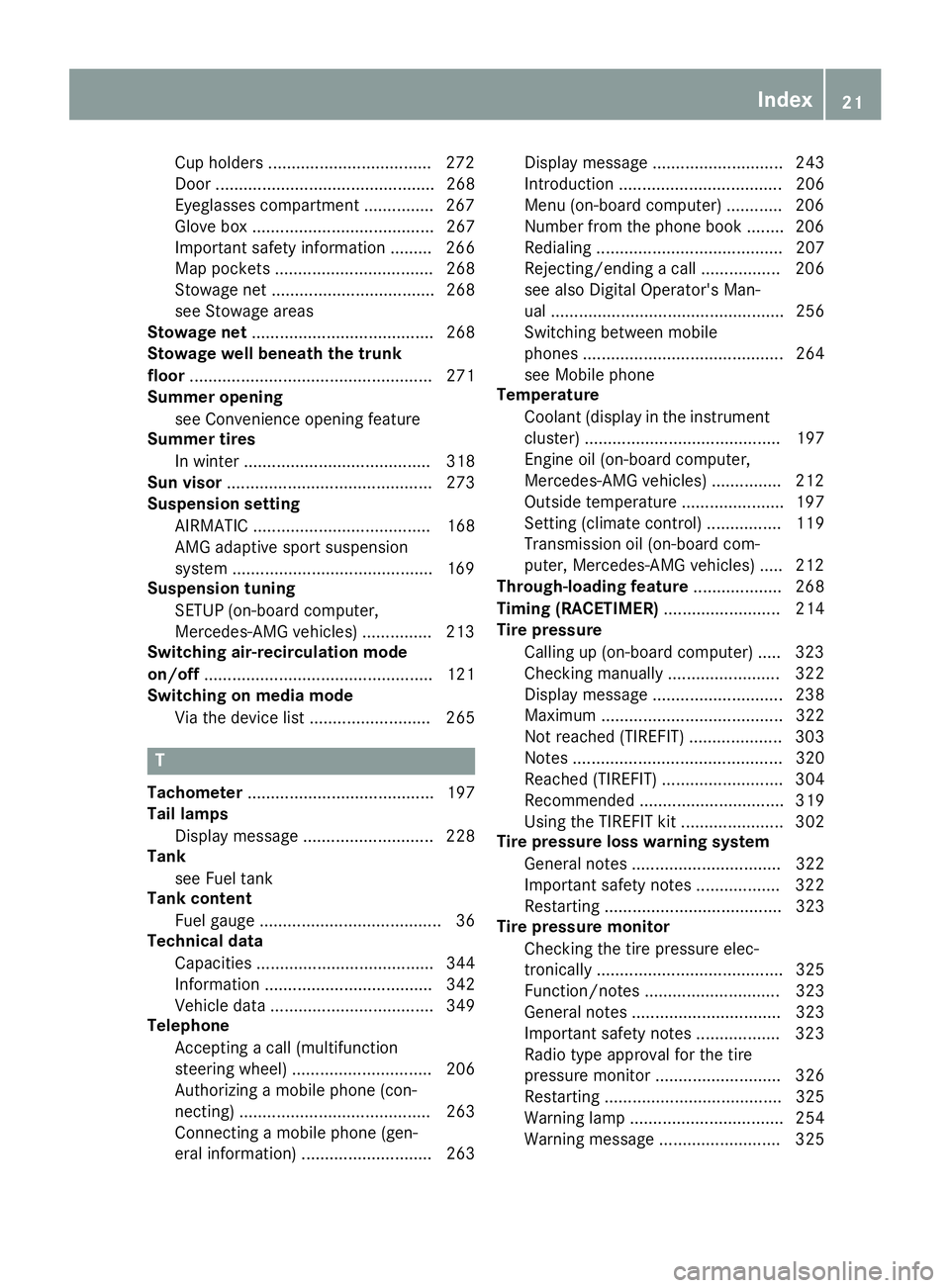
Cup holders ...................................272
Door ............................................... 268
Eyeglasses compartment ...............2 67
Glove box ....................................... 267
Important safety information ......... 266
Map pockets .................................. 268
Stowage net ................................... 268
see Stowage areas
Stowage net ....................................... 268
Stowage well beneath the trunk
floor .................................................... 271
Summer opening
see Convenience opening feature
Summer tires
In winter ........................................ 318
Sun visor ............................................ 273
Suspension setting
AIRMATIC ...................................... 168
AMG adaptive sport suspension
system ...........................................1 69
Suspension tuning
SETUP (on-board computer,
Mercedes-AMG vehicles) ...............2 13
Switching air-recirculation mode
on/off ................................................. 121
Switching on media mode
Via the device list .......................... 265
T
Tachometer ........................................ 197
Tail lamps
Display message ............................ 228
Tank
see Fuel tank
Tank content
Fuel gauge ....................................... 36
Technical data
Capacities ...................................... 344
Information .................................... 342
Vehicle data ................................... 349
Telephone
Accepting a call (multifunction
steering wheel) .............................. 206
Authorizing a mobile phone (con-
necting) ......................................... 263
Connecting a mobile phone (gen-
eral information) ............................ 263 Display message ............................ 243
Introduction ................................... 206
Menu (on-board computer) ............ 206
Number from the phone book ........ 206
Redialing ........................................ 207
Rejecting/ending a call ................. 206
see also Digital Operator's Man-
ual .................................................. 256
Switching between mobile
phones ........................................... 264
see Mobile phone
Temperature
Coolant (display in the instrument
cluster) .......................................... 197
Engine oil (on-board computer,
Mercedes-AMG vehicles) ............... 212
Outside temperature ...................... 197
Setting (climate control) ................ 119
Transmission oil (on-board com-
puter, Mercedes-AMG vehicles) ..... 212
Through-loading feature ................... 268
Timing (RACETIMER) ......................... 214
Tire pressure
Calling up (on-board computer) ..... 323
Checking manually ........................ 322
Display message ............................ 238
Maximum ....................................... 322
Not reached (TIREFIT) .................... 303
Notes ............................................. 320
Reached (TIREFIT) .......................... 304
Recommended ............................... 319
Using the TIREFIT kit ...................... 302
Tire pressure loss warning system
General notes ................................ 322
Important safety notes .................. 322
Restarting ...................................... 323
Tire pressure monitor
Checking the tire pressure elec-
tronically ........................................ 325
Function/notes ............................. 323
Genera l note
s ................................ 323
Important safety notes .................. 323
Radio type approval for the tire
pressure monitor ........................... 326
Restarting ...................................... 325
Warning lamp ................................. 254
Warning message .......................... 325
Index21
Page 148 of 354
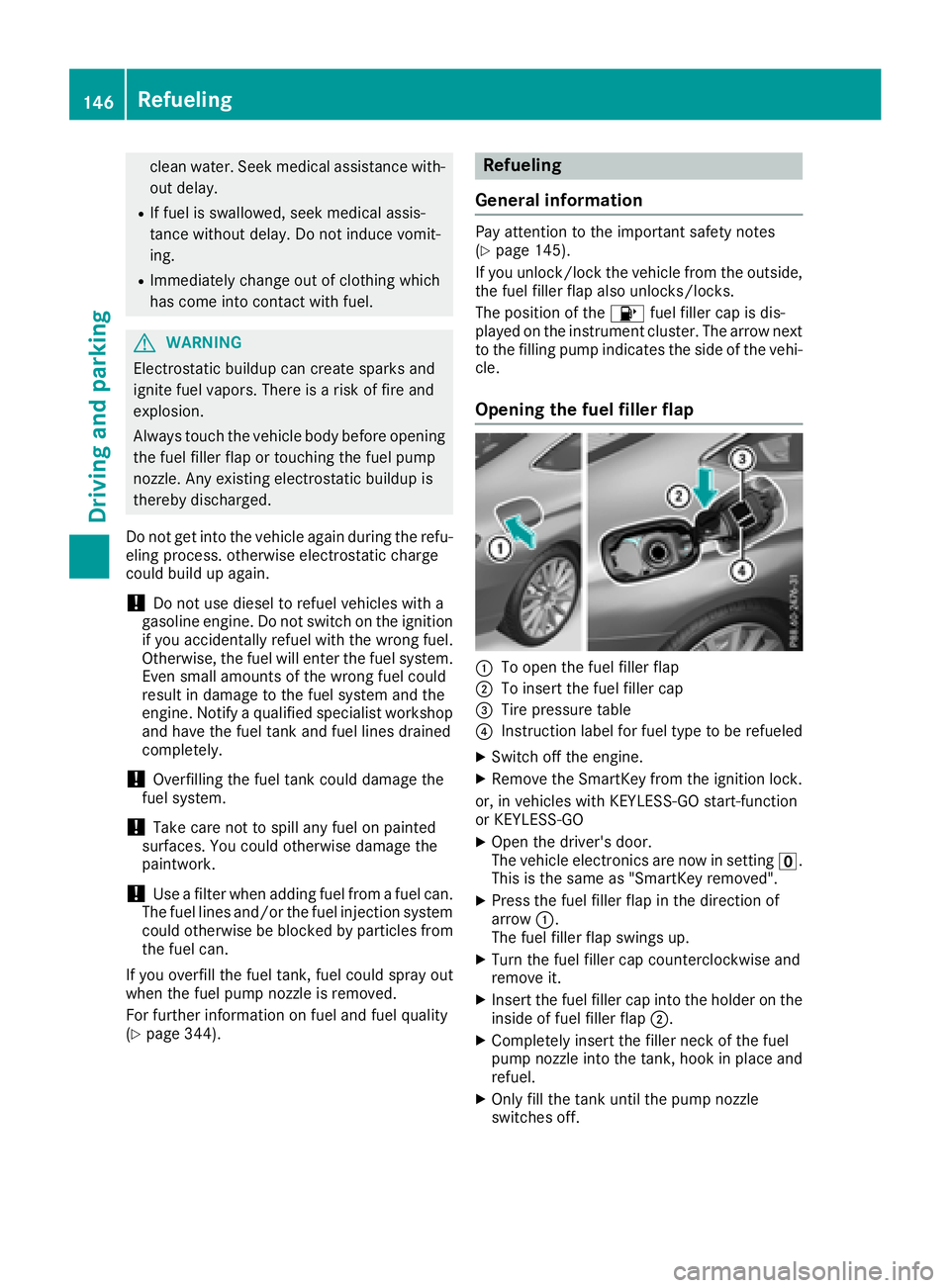
clean water. Seek medical assistance with-
out delay.
RIf fuel is swallowed, seek medical assis-
tance without delay. Do not induce vomit-
ing.
RImmediately change out of clothing which
has come into contact with fuel.
GWARNING
Electrostatic buildup can create sparks and
ignite fuel vapors. There is a risk of fire and
explosion.
Always touch the vehicle body before opening
the fuel filler flap or touching the fuel pump
nozzle. Any existing electrostatic buildup is
thereby discharged.
Do not get into the vehicle again during the refu-
eling process. otherwise electrostatic charge
could build up again.
!Do not use diesel to refuel vehicles with a
gasoline engine. Do not switch on the ignition
if you accidentally refuel with the wrong fuel.
Otherwise, the fuel will enter the fuel system. Even small amounts of the wrong fuel could
result in damage to the fuel system and the
engine. Notify a qualified specialist workshop
and have the fuel tank and fuel lines drained
completely.
!Overfilling the fuel tank could damage the
fuel system.
!Take care not to spill any fuel on painted
surfaces. You could otherwise damage the
paintwork.
!Use a filter when adding fuel from a fuel can.
The fuel lines and/or the fuel injection system
could otherwise be blocked by particles from
the fuel can.
If you overfill the fuel tank, fuel could spray out
when the fuel pump nozzle is removed.
For further information on fuel and fuel quality
(
Ypage 344).
Refueling
General information
Pay attention to the important safety notes
(Ypage 145).
If you unlock/lock the vehicle from the outside,
the fuel filler flap also unlocks/locks.
The position of the 8fuel filler cap is dis-
played on the instrument cluster. The arrow next
to the filling pump indicates the side of the vehi-
cle.
Opening the fuel filler flap
:To open the fuel filler flap
;To insert the fuel filler cap
=Tire pressure table
?Instruction label for fuel type to be refueled
XSwitch off the engine.
XRemove the SmartKey from the ignition lock.
or, in vehicles with KEYLESS-GO start-function
or KEYLESS ‑GO
XOpen the driver's door.
The vehicle electronics are now in setting u.
This is the same as "SmartKey removed".
XPress the fuel filler flap in the direction of
arrow :.
The fuel filler flap swings up.
XTurn the fuel filler cap counterclockwise and
remove it.
XInsert the fuel filler cap into the holder on the
inside of fuel filler flap ;.
XCompletely insert the filler neck of the fuel
pump nozzle into the tank, hook in place and
refuel.
XOnly fill the tank until the pump nozzle
switches off.
146Refueling
Driving and parking
Page 149 of 354

Do not add any more fuel after the pump stops
filling for the first time. Otherwise, fuel may leak
out.
Closing the fuel filler flap
XReplace the cap on the filler neck and turn
clockwise until it engages audibly.
XClose the fuel filler flap.Close the fuel filler flap before locking the vehi-
cle.
If you are driving with the fuel filler cap open, the
8
reserve fuel warning lamp flashes. A mes-
sage appears in the multifunction display
(
Ypage 232).
Problems with fuel and the fuel tank
ProblemPossible causes/consequences and MSolutions
Fuel is leaking from the
vehicle.GWARNING
The fuel line or the fuel tank is faulty.
Risk of explosion or fire.
XApply the electric parking brake.
XSwitch off the engine.
XRemove the SmartKey from the ignition lock.
or, in vehicles with KEYLESS-GO start-function or KEYLESS ‑GO
XOpen the driver's door.
The vehicle electronics are now in positionu. This is the same as
the key having been removed.
XDo not restart the engine under any circumstances.
XConsult a qualified specialist workshop.
The fuel filler flap cannot
be opened.The fuel filler flap is not unlocked.
XUnlock the vehicle (Ypage 75).
The SmartKey battery is discharged or nearly discharged.
XUnlock the vehicle using the mechanical key (Ypage 77).
The fuel filler flap is unlocked, but the opening mechanism is jammed.
XConsult a qualified specialist workshop.
Parking
Important safety notes
GWARNING
Flammable material such as leaves, grass or
twigs may ignite if they come into contact with
hot parts of the exhaust system or exhaust
gas flow. There is a risk of fire.
Park the vehicle so that no flammable mate-
rials come into contact with parts of the vehi-
cle which are hot. Take particular care not to
park on dry grassland or harvested grain
fields.
Parking147
Driving an d parking
Z
Page 234 of 354
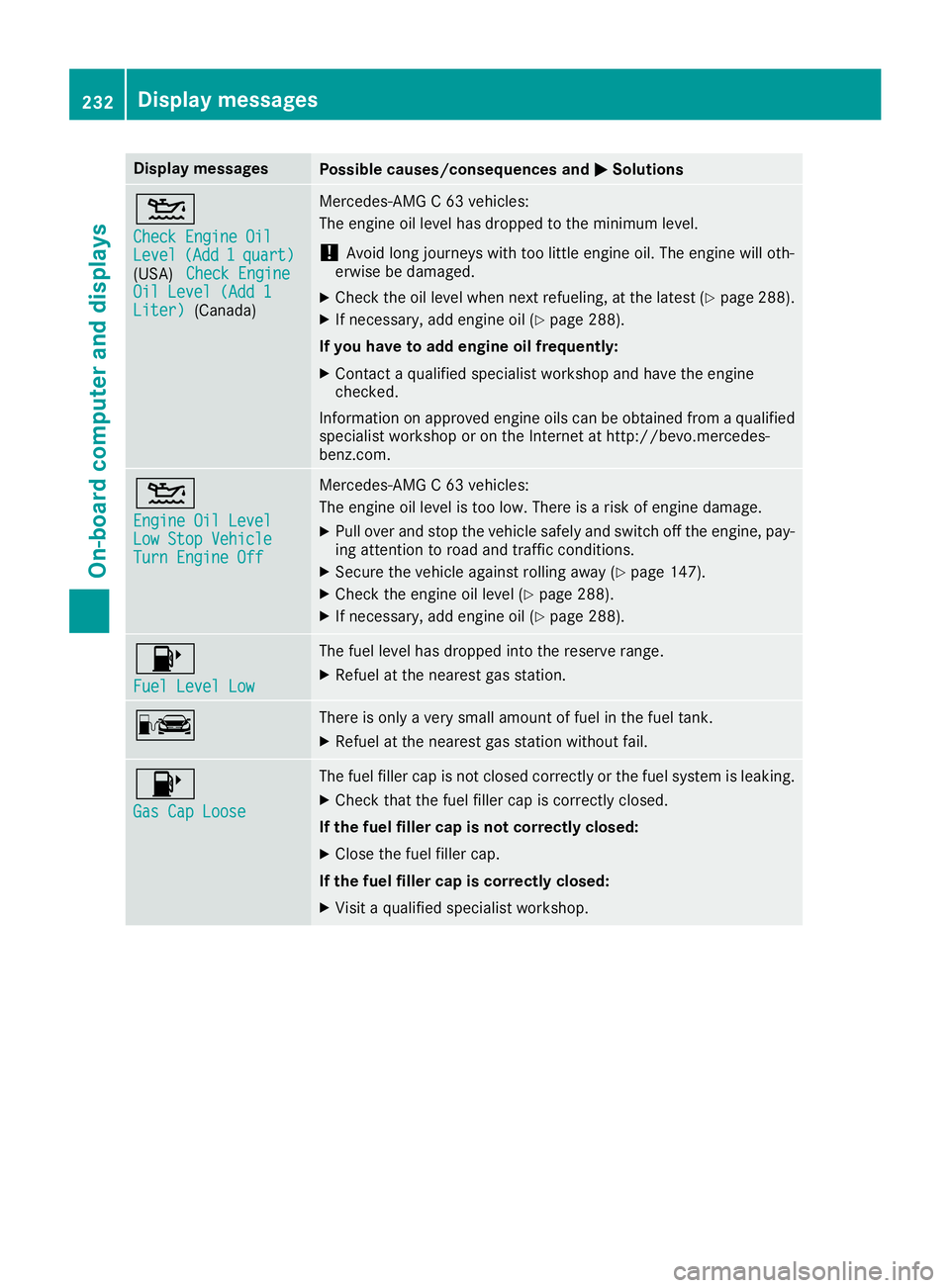
Display messagesPossible causes/consequences andMSolutions
4
Check Engine OilLevel(Add1quart)(USA) Check EngineOil Level (Ad d 1Liter)(Canada)
Mercedes-AMGC63 vehicles:
The engin eoil level has dropped to th eminimum level.
!Avoid lon gjourneys wit hto olittl eengin eoil. The engin ewill oth-
erwise be damaged.
XChec kth eoil level when next refueling, at th elatest (Ypage 288).
XIf necessary, add engin eoil (Ypage 288).
If you have to ad dengin eoil frequently:
XContac t aqualified specialist workshop and hav eth eengin e
checked.
Information on approve dengin eoils can be obtained from aqualified
specialist workshop or on th eInternet at http://bevo.mercedes -
benz.co m.
4
Engine Oil LevelLow Stop VehicleTurn Engine Off
Mercedes-AMG C 63 vehicles:
The engine oil level is too low. There is a risk of engine damage.
XPull over and stop the vehicle safely and switch off the engine, pay-
ing attention to road and traffic conditions.
XSecure the vehicle against rolling away (Ypage 147).
XCheck the engine oil level (Ypage 288).
XIf necessary, add engine oil (Ypage 288).
8
Fuel Level Low
The fuel level has dropped into the reserve range.
XRefuel at the nearest gas station.
CThere is only a very small amount of fuel in the fuel tank.
XRefuel at the nearest gas station without fail.
8
Gas Cap Loose
The fuel filler cap is not closed correctly or the fuel system is leaking.
XCheck that the fuel filler cap is correctly closed.
If the fuel filler cap is not correctly closed:
XClose the fuel filler cap.
If the fuel filler cap is correctly closed:
XVisit a qualified specialist workshop.
232Display messages
On-board computer and displays
Page 253 of 354
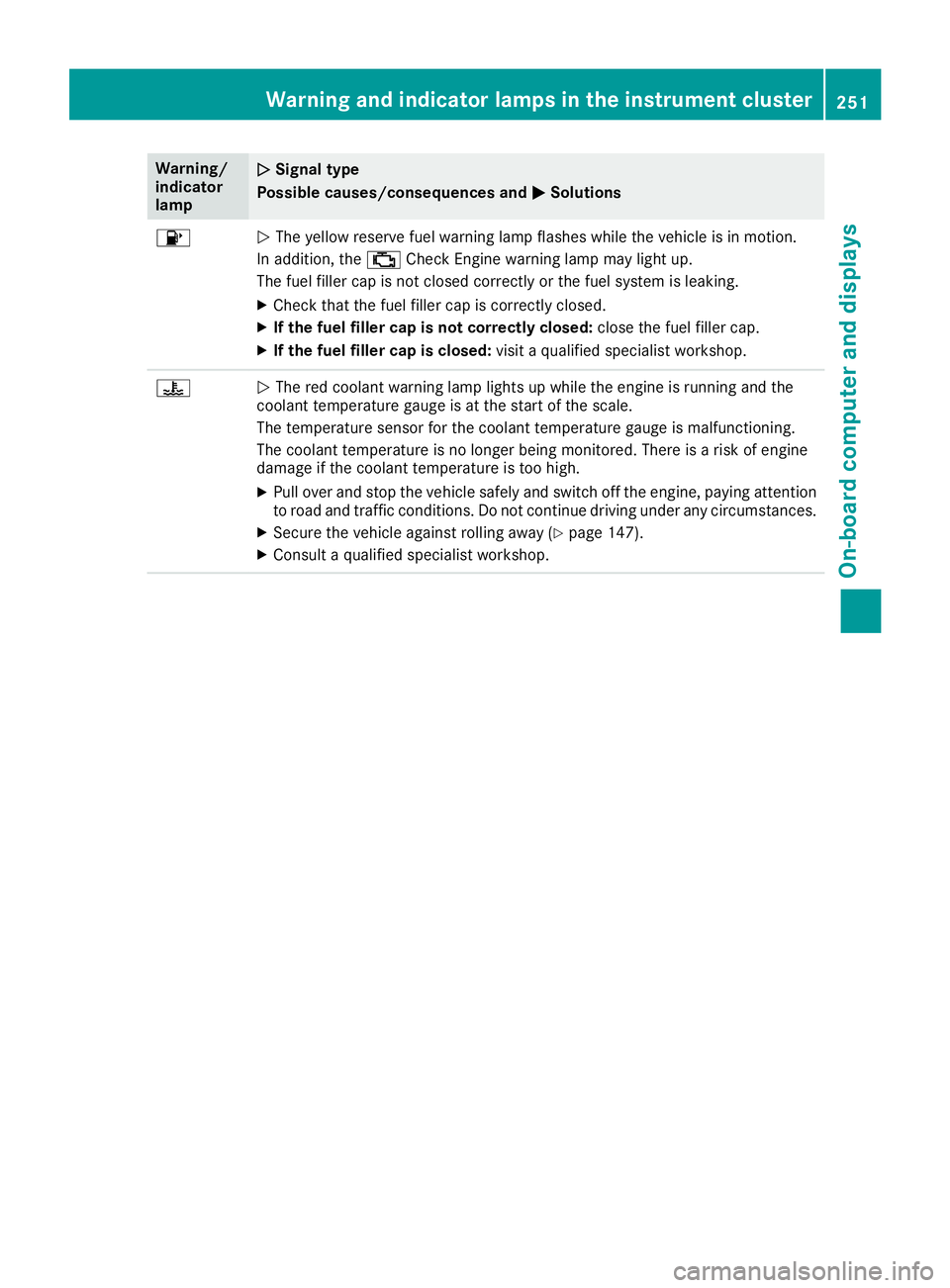
Warning/
indicator
lampNSignal type
Possible causes/consequences and M
Solutions
8NThe yellow reserve fuel warning lamp flashes while the vehicle is in motion.
In addition, the ;Check Engine warning lamp may light up.
The fuel filler cap is not closed correctly or the fuel system is leaking.
XCheck that the fuel filler cap is correctly closed.
XIf the fuel filler cap is not correctly closed: close the fuel filler cap.
XIf the fuel filler cap is closed:visit a qualified specialist workshop.
?NThe red coolant warning lamp lights up while the engine is running and the
coolant temperature gauge is at the start of the scale.
The temperature sensor for the coolant temperature gauge is malfunctioning.
The coolant temperature is no longer being monitored. There is a risk of engine
damage if the coolant temperature is too high.
XPull over and stop the vehicle safely and switch off the engine, paying attention
to road and traffic conditions. Do not continue driving under any circumstances.
XSecure the vehicle against rolling away (Ypage 147).
XConsult a qualified specialist workshop.
Warning and indicator lamps in the instrument cluster251
On-board computer and displays
Z
Page 306 of 354
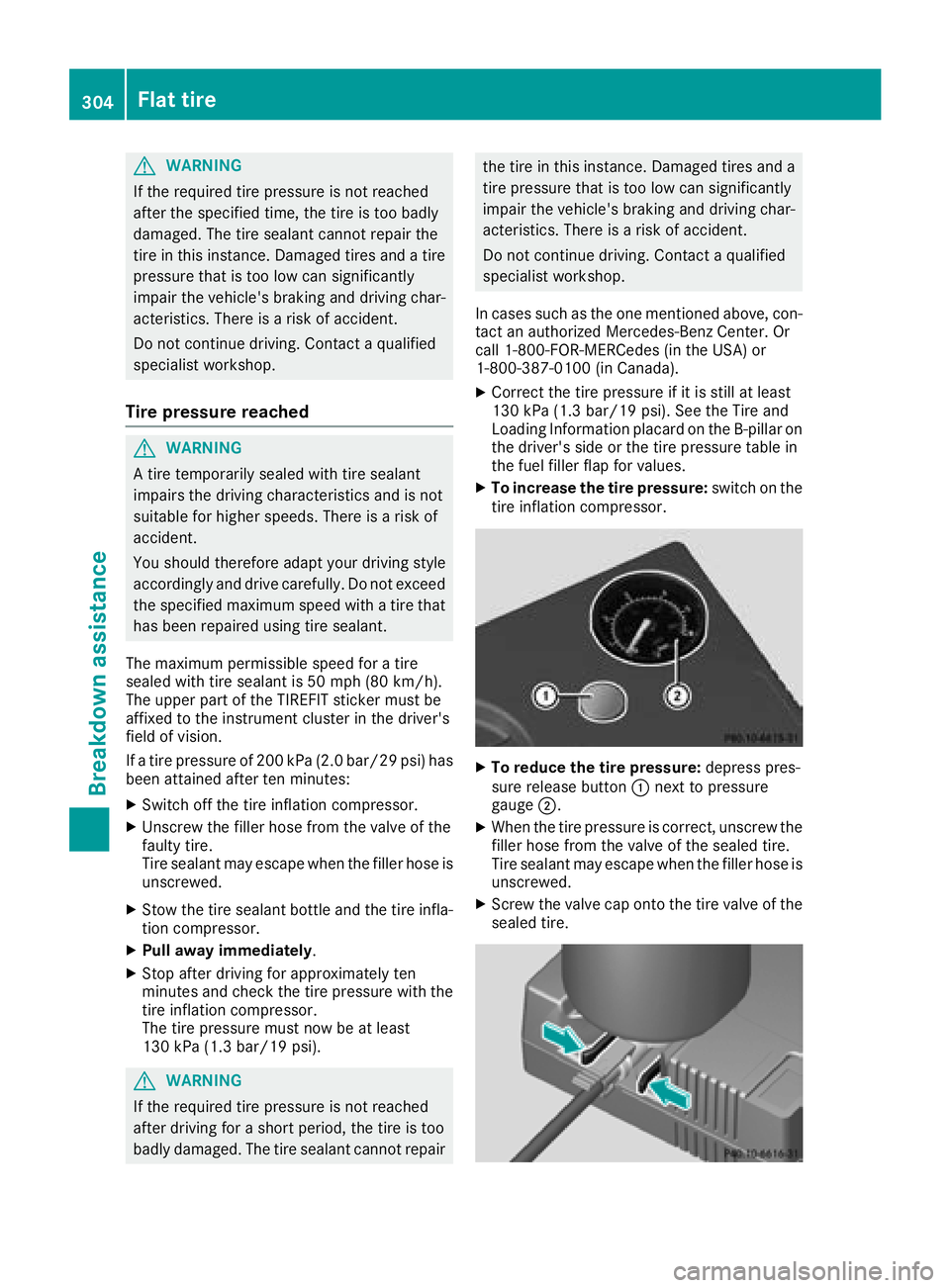
GWARNING
If the required tire pressure is not reached
after the specified time, the tire is too badly
damaged. The tire sealant cannot repair the
tire in this instance. Damaged tires and a tire
pressure that is too low can significantly
impair the vehicle's braking and driving char-
acteristics. There is a risk of accident.
Do not continue driving. Contact a qualified
specialist workshop.
Tire pressure reached
GWARNING
A tire temporarily sealed with tire sealant
impairs the driving characteristics and is not
suitable for higher speeds. There is a risk of
accident.
You should therefore adapt your driving style
accordingly and drive carefully. Do not exceed the specified maximum speed with a tire that
has been repaired using tire sealant.
The maximum permissible speed for a tire
sealed with tire sealant is 50 mph (80 km/h).
The upper part of the TIREFIT sticker must be
affixed to the instrument cluster in the driver's
field of vision.
If a tire pressure of 200 kPa (2.0 bar/29 psi) has
been attained after ten minutes:
XSwitch off the tire inflation compressor.
XUnscrew the filler hose from the valve of the
faulty tire.
Tire sealant may escape when the filler hose is
unscrewed.
XStow the tire sealant bottle and the tire infla-
tion compressor.
XPull away immediately .
XStop after driving for approximately ten
minutes and check the tire pressure with the
tire inflation compressor.
The tire pressure must now be at least
130 kPa (1.3 bar/19 psi).
GWARNING
If the required tire pressure is not reached
after driving for a short period, the tire is too
badly damaged. The tire sealant cannot repair
the tire in this instance. Damaged tires and a
tire pressure that is too low can significantly
impair the vehicle's braking and driving char-
acteristics. There is a risk of accident.
Do not continue driving. Contact a qualified
specialist workshop.
In cases such as the one mentioned above, con-
tact an authorized Mercedes-Benz Center. Or
call 1-800-FOR-MERCedes (in the USA) or
1-800-387-0100 (in Canada).
XCorrect the tire pressure if it is still at least
130 kPa (1.3 bar/19 psi). See the Tire and
Loading Information placard on the B-pillar on
the driver's side or the tire pressure table in
the fuel filler flap for values.
XTo increase the tire pressure: switch on the
tire inflation compressor.
XTo reduce the tire pressure: depress pres-
sure release button :next to pressure
gauge ;.
XWhen the tire pressure is correct, unscrew the
filler hose from the valve of the sealed tire.
Tire sealant may escape when the filler hose is
unscrewed.
XScrew the valve cap onto the tire valve of the
sealed tire.
304Flat tire
Breakdown assistance
Page 310 of 354
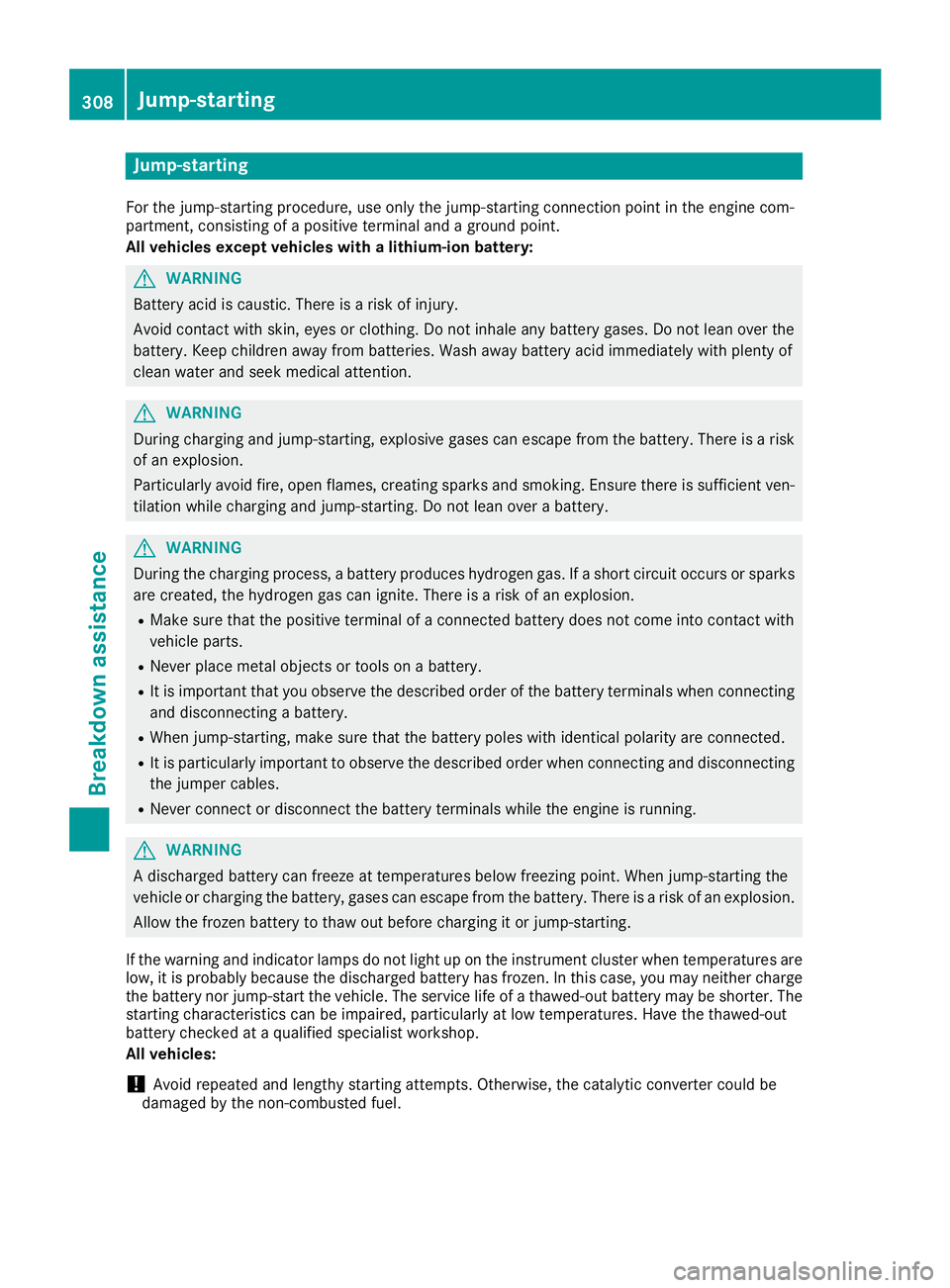
Jump-starting
For the jump-starting procedure, use only the jump-starting connection point in the engine com-
partment, consisting of a positive terminal and a ground point.
All vehicles except vehicles with a lithium-ion battery:
GWARNING
Battery acid is caustic. There is a risk of injury.
Avoid contact with skin, eyes or clothing. Do not inhale any battery gases. Do not lean over the
battery. Keep children away from batteries. Wash away battery acid immediately with plenty of
clean water and seek medical attention.
GWARNING
During charging and jump-starting, explosive gases can escape from the battery. There is a risk of an explosion.
Particularly avoid fire, open flames, creating sparks and smoking. Ensure there is sufficient ven-
tilation while charging and jump-starting. Do not lean over a battery.
GWARNING
During the charging process, a battery produces hydrogen gas. If a short circuit occurs or sparks
are created, the hydrogen gas can ignite. There is a risk of an explosion.
RMake sure that the positive terminal of a connected battery does not come into contact with
vehicle parts.
RNever place metal objects or tools on a battery.
RIt is important that you observe the described order of the battery terminals when connecting
and disconnecting a battery.
RWhen jump-starting, make sure that the battery poles with identical polarity are connected.
RIt is particularly important to observe the described order when connecting and disconnecting
the jumper cables.
RNever connect or disconnect the battery terminals while the engine is running.
GWARNING
A discharged battery can freeze at temperatures below freezing point. When jump-starting the
vehicle or charging the battery, gases can escape from the battery. There is a risk of an explosion. Allow the frozen battery to thaw out before charging it or jump-starting.
If the warning and indicator lamps do not light up on the instrument cluster when temperatures are low, it is probably because the discharged battery has frozen. In this case, you may neither charge
the battery nor jump-start the vehicle. The service life of a thawed-out battery may be shorter. The
starting characteristics can be impaired, particularly at low temperatures. Have the thawed-out
battery checked at a qualified specialist workshop.
All vehicles:
!Avoid repeated and lengthy starting attempts. Otherwise, the catalytic converter could be
damaged by the non-combusted fuel.
308Jump-starting
Breakdown assistance
Page 323 of 354
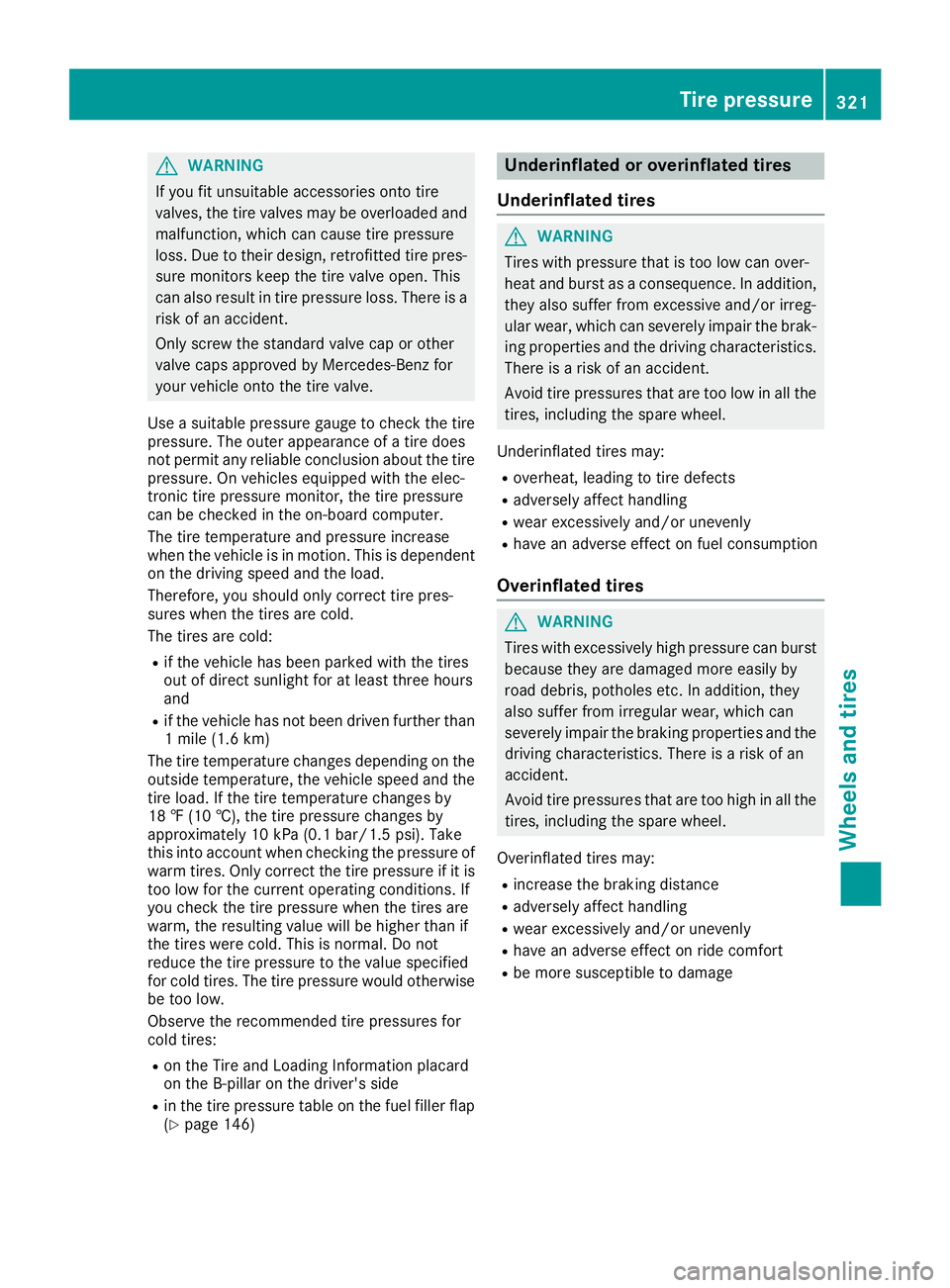
GWARNING
If you fit unsuitable accessories onto tire
valves, the tire valves may be overloaded and
malfunction, which can cause tire pressure
loss. Due to their design, retrofitted tire pres- sure monitors keep the tire valve open. This
can also result in tire pressure loss. There is a
risk of an accident.
Only screw the standard valve cap or other
valve caps approved by Mercedes-Benz for
your vehicle onto the tire valve.
Use a suitable pressure gauge to check the tire
pressure. The outer appearance of a tire does
not permit any reliable conclusion about the tire pressure. On vehicles equipped with the elec-
tronic tire pressure monitor, the tire pressure
can be checked in the on-board computer.
The tire temperature and pressure increase
when the vehicle is in motion. This is dependent
on the driving speed and the load.
Therefore, you should only correct tire pres-
sures when the tires are cold.
The tires are cold:
Rif the vehicle has been parked with the tires
out of direct sunlight for at least three hours
and
Rif the vehicle has not been driven further than
1 mile (1.6 km)
The tire temperature changes depending on the
outside temperature, the vehicle speed and the
tire load. If the tire temperature changes by
18 ‡ (10 †), the tire pressure changes by
approximately 10 kPa (0.1 bar/1.5 psi). Take
this into account when checking the pressure of
warm tires. Only correct the tire pressure if it is
too low for the current operating conditions. If
you check the tire pressure when the tires are
warm, the resulting value will be higher than if
the tires were cold. This is normal. Do not
reduce the tire pressure to the value specified
for cold tires. The tire pressure would otherwise
be too low.
Observe the recommended tire pressures for
cold tires:
Ron the Tire and Loading Information placard
on the B-pillar on the driver's side
Rin the tire pressure table on the fuel filler flap
(Ypage 146)
Underinflated or overinflated tires
Underinflated tires
GWARNING
Tires with pressure that is too low can over-
heat and burst as a consequence. In addition, they also suffer from excessive and/or irreg-
ular wear, which can severely impair the brak-
ing properties and the driving characteristics.
There is a risk of an accident.
Avoid tire pressures that are too low in all the
tires, including the spare wheel.
Underinflated tires may:
Roverheat, leading to tire defects
Radversely affect handling
Rwear excessively and/or unevenly
Rhave an adverse effect on fuel consumption
Overinflated tires
GWARNING
Tires with excessively high pressure can burst
because they are damaged more easily by
road debris, potholes etc. In addition, they
also suffer from irregular wear, which can
severely impair the braking properties and the driving characteristics. There is a risk of an
accident.
Avoid tire pressures that are too high in all the
tires, including the spare wheel.
Overinflated tires may:
Rincrease the braking distance
Radversely affect handling
Rwear excessively and/or unevenly
Rhave an adverse effect on ride comfort
Rbe more susceptible to damage
Tire pressure321
Wheels and tires
Z